Twillingate, Newfoundland 作者: 来源: 发布时间:2021-12-09
I.Population and Area
-Area
•Land: 25.74 km2 (9.94 sq mi)
-Population (2016)
-Total: 2,196
-Density: 85.3/km2 (221/sq mi)
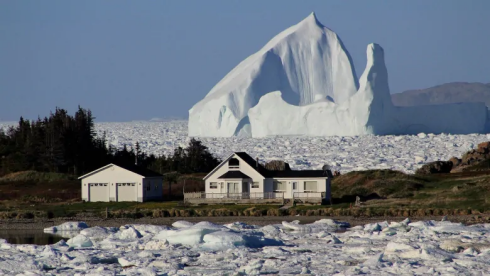
II.Natural Geography (environment and resources)
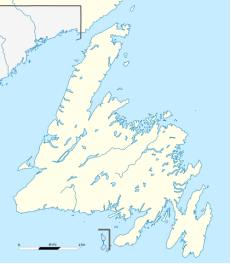
-Twillingate is a town of 2,196 people located on the Twillingate Islands ("Toulinquet") in Notre Dame Bay, off the north eastern shore of the island of Newfoundland in the province of Newfoundland and Labrador, Canada. The town is about 100 kilometres (62 mi) north of Lewisporte and Gander.
-Incorporated on September 30, 1965, the town of Twillingate includes such localities as Back Harbour, Bayview, Durrell, Gillard's Cove, Jenkins Cove, Manuel's Cove, and Wild Cove. The Twillingate Islands provide an excellent sheltered harbour and easy access to the rich fishing grounds nearby. Twillingate Island is connected to mainland Newfoundland via the Walter B. Elliott causeway as part of Route 340. The town is also one of the oldest ports on the island. It was a historic fishing community, but because of the decline of the fishing industry, its economy now relies more on tourism.
-Twillingate is easily accessed by Route 340 from Lewisporte if approaching from western Newfoundland or by Route 330 from Gander if approaching from eastern Newfoundland. The town of Twillingate is approximately 1.5 hours from Gander and about an hour from Lewisporte. Somebody driving north on Route 340 from Lewisporte or Gander to Twillingate will pass through many other small fishing communities, including Boyd's Cove, Summerford, Virgin Arm and Newville.
-There are several very small fishing communities that can be found on Twillingate Island before reaching the main town. The first community is Black Duck Cove and after that, a person will pass by Purcell's Harbour and Little Harbour. The western portion of the island, a series of communities now amalgamated into Bayview is accessible via Rink Road, which becomes Bayview Street shortly after it starts, in the town or by a gravel road before entering the town. These communities, in order from the Route 340-gravel road entry are Kettle Cove, Manuel's Cove, Gillard's Cove, Bluff Head Cove, Davis Cove and Ragged Point. The town of Twillingate is about 5 km (3.1 mi) from the Twillingate-New World Island causeway. When in the town, access to the northern island is provided by "Tickle Bridge" and the communities on the southern island can be accessed via the town's main road.
-Route 340 runs through Twillingate as Toulinguet Street and Main Street. After turning left at the town's main intersection (Toulinguet and Main), Route 340 runs through northern portion of the town and continues through the surrounding communities on the northern island, Back Harbour, Paradise and Wild Cove, then after a 0.5 km stretch enters the town of Crow Head and continues to the Long Point Lighthouse. If one turns right at the main intersection, that portion of Main Street (which isn't part of Route 340) will take them through the town on the southern island, then into Durrell, ending near French Beach in Lower Jenkins' Cove.
-The terrain is mildly to moderately hilly even though there are no mountains near the Twillingate area. The highest point in Twillingate can be reached by the "Top of Twillingate Walking Trail", which is located off Bayview Street. Elevation varies significantly throughout the town. The main southern and northern sides of the town in addition to the neighbourhoods of Wild Cove, Back Harbour, Hart's Cove, and portions of Bayview and Durrell are near sea level. Other parts of Durrell, Bayview and the central area of the town are situated on more elevated land. Forests can be literally be found everywhere around town.
-The region is known for its scenic, rugged coastline and its quiet and friendly atmosphere. Icebergs can be seen around the coastline in the summer months.
III.ECONOMY

-Website: https://www12.statcan.gc.ca/census-recensement/2016/dp-pd/prof/details/page.cfm?Lang=E&Geo1=CSD&Code1=1008035&Geo2=PR&Code2=60&Data=Count&SearchText=Paradise&SearchType=Begins&SearchPR=01&B1=All
IV.Industrial Characteristics
-Today, Twillingate's economy revolves primarily around careers in construction, logging and the tertiary sector, which involves providing services to the community. Because of the cod moratorium in 1992, fishing is not practised as much in the area, though some fishermen still catch crab, lobster and other aquatic species. The seal hunt is practised in Twillingate.
-Tourism throughout the summer months is also a big part of the economy in the Twillingate area. The town is known as the "Iceberg Capital of the World" because of the scenery and icebergs that are seen in the spring months. The Fish, Fun and Folk Festival draws many tourists from across the world to the town each year and showcases local talent while economically helping the town and its people. The Long Point Lighthouse, found near Crow Head, is a popular tourist attraction, as are the humpback whales that can be seen in the Atlantic Ocean.
-Services
•The town has two schools; Twillingate Elementary for kindergarten to Grade 6 and J.M. Olds Collegiate for Grade 7 to Grade 12. Both of the schools fall under the Nova Central School District.
•Medical services are provided by the small Notre Dame Bay Memorial Health Care Centre. Originally opened in 1924, it was later expanded. After its expansion, it was partially destroyed by fire. In 1976, the original 49-bed hospital was torn down and replaced by a 69-bed facility. Afterwards, due to budget measures, it was reduced to 46 beds.
•Policing of the New World Island and Twillingate areas are provided by the Royal Canadian Mounted Police, Division B.
•Twillingate has its own Fire Department, made possible by volunteers. The fire department is located in the Town Hall building, at the corner of Main Street and Blandford's Lane on the south side.
•Telephone services were first supplied by Twillingate Telephone and Electric. It was later purchased, in 1951, by Canadian National Telecommunications. This company later formed Terra Nova Tel. In 1988, Terra Noval Tel was purchased by NewTel Communications, which was a holding company of NewTel Enterprises. In 1999, NewTel Enterprises merged with other companies. Today, telephone service is provided by Aliant. Aliant also provides DSL internet service to the community.
•Eastlink, formerly operating as Persona Communications, provides both high speed internet and cable television to the community, as well as the cable-only House of Assembly Channel. The town receives CJON-TV, known as "NTV". NTV is rebroadcast as CJCN-TV from Norris Arm, as well as CBNT (CBC), which is rebroadcast as CBNAT from Grand Falls-Windsor.
V.Attractions
1.Whale Watching
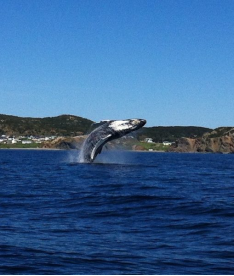
-Every year from mid May to September a variety of whales swim through the rich feeding waters along the coast of Newfoundland. The highlight of whale watching is seeing a whale tale above the surface.
-Finger on the Shutter
-As many as 22 species of whales have been recorded in the waters around Newfoundland, such as humpbacks, fin whales, sperm whales, blue whales, minke whales, pilot whales and potheads. When going out by boat, keep your camera ready because you may see even dolphins, seals and a variety of sea birds.
-Humpback and Minke Whales
-Try watching this video on www.youtube.com, or enable JavaScript if it is disabled in your browser.
-Humpbacks and minke whales are the most common whale species but dolphins and fin whales are also occasionally seen. Humpback tails are as distinctive as human faces or fingerprints.
-Lookout at Long Point
-Humpback whale breeching in Twillingate
-The lookout point at Twillingate’s Long Point Lighthouse is a good spot for whale watching, but a surprise may await anywhere along the coastline. Twillingate’s many tour operators have daily tours to bring you close to whales, icebergs and other marine life.
-The coves and islands in Notre Dame Bay create the perfect conditions for sea kayaking – another perfect way to get close (not too close) to these sea mammals!
-Twillingate is also the home of North America’s largest population of humpbacks, seabirds and yet both the sea and shores remain pristine and enchanting.
-Youtube Video: https://youtu.be/Pear_FkqbFI
-Website: https://twillingate.com/to-see-do/iceberg-whales/
2.Beothuk Interpretation Centre
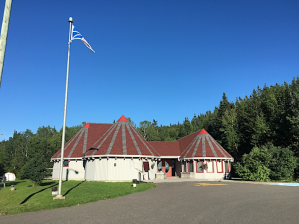
-Archeological Findings
-The Beothuk dwelled along the coast line of Notre Dame Bay and the Boyd’s Cove Beothuk Intrepretation Centre today marks the site of significant archeological findings. It is a provincial historic site worth a visit.
-Discovered in 1981 through an archaeological survey, the site is a testament to the Beothuk First Nation that occupied it from 1650-1720.
-Interpretation Centre
-Walk down a groomed trail past the captivating outlines of several Beothuk houses and as you do you’ll be drawn into imagining life in their thriving village 300 years ago. Tour the interpretation centre where exhibits and artifacts from the site foster an appreciation for these now-extinct people. The interpretive display is based on recent archaeological research at a large Beothuk village circa 1650-1720.
-The exhibit area is broken into two main areas: archaeological information and Beothuck culture. The archaeological section consists of information boards depicting the discovery of the Boyd’s Cove site and the archaeological excavations, and showcases various artifacts excavated from the site including projectile points.
-Likewise, based on the archaeological evidence, the Beothuk culture exhibit focuses on the diet, spirituality and manufacturing of tools and house. At the rear of the building, a walking trail links the Centre to the area on which the archaeological excavations occurred. Visitors may also view the various flora and fauna that inhabit the area.
-Open: May – October 10:00 am – 5:30 pm. Open seven days a week including weekends and holidays.
-At Boyd’s Cove (Route 340 from Lewisporte or Route 331 from the Gander Bay Junction)
-Website: https://twillingate.com/to-see-do/other-attractions/
3.The Split Peas
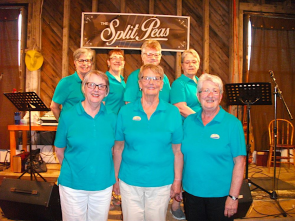
-Seven women who bring the feel of a Newfoundland kitchen party to the stage at Touton House (the Orange Lodge) every Tuesday during the summer.
-Over the years they have performed throughout Newfoundland: and also, at the Lunenburg Folk Harbour Festival in Nova Scotia and Breakfast TV in Toronto.
-Their music has been featured in the movie "The Shipping News" and on CBC's Land and Sea and Music Craft. Over the years they have also completed 7 recordings, three of which will be available this summer.
-Come and enjoy an evening of music and fun suitable for all the family.
-In 2020 The Split Peas celebrates 27 years of performing together as a group!
-CDs for sale at each performance
-Admission:
• $20.00
- Tickets:
•Available at Twillingate Museum from 9:00 am - 4:30 pm
- When:
•Performances every Tuesday evening at 7:00 pm from June 16 2020 to August 25 2020
- Where:
•Touton House, Orange Lodge, 118 Main Street Twillingate
-Contact Information:
•Local Phone: 709-884-2282
•GPS: 49.65038,-54.770763
•Website: margaretmanuel@personainternet.com
VI.History
-Twillingate is one of the few areas in Newfoundland that can trace its history back 3500 years to the inhabitation of Archaic Maritime Indians around 1500 BC. It was the scene of an important archeological find in 1966.
-Twillingate is one of the oldest seaports in Newfoundland. The French fishing fleet used the waters around the island between 1650 and 1690 and it was these fishermen who gave the islands the name "Toulinquet" because of their similarity to a group of islands offthe French coast near Brest. The name became anglicized to Twillingate with the first formal settlement of a town was around 1700. The first livyers, or permanent settlers, were English fishermen and their families from Devonshire. By 1760, records show that two main merchants were bringing in over a thousand pounds worth of business a year.
-With the growth of a seal fishery in the 18th century, settlers became more enterprising and were engaged almost year round with fishing and farming in the summer and autumn and the seal fishery the spring.
-At this time the islands were heavily wooded and occupied by bands of Beotlvk Indians. The settlers disregarded the Beothuks' aboriginal rights to their traditional fishing and hunting grounds and the Beothuks responded by petty thieving. The second last living Beothuk, Demasuit, or Mary March as she was to be called, was captured and brought to live in Twillingate in 1819 where she later contracted tuberculosis and died.
-Twillingate prides itself as the birthplace of a world renowned opera star. Georgina Sterling was born in 1867, the youngest daughter of Twillingate's first doctor, William Sterling. After showing early signs of possessing a remarkable soprano voice, she was sent to train in Italy and later toured Italy and the United States to wide acclaim. Her career was cut short when she contracted an illness that caused her to lose her voice and she returned to Twillingate where she died in 1935. In 1964, the still proud citizens of Twillingate erected a headstone to mark her grave and inscribed it: The nightingale of the North sang fairer than the larks of Italy. She entertained royalty by her voice, the poor by the kindness of her heart. Erected by an admiring public, 1964.
-The original Notre Dame Bay Memorial Hospital was built by the people of Twillingate between 1921 and 1924 as a memorial to the casualties of the First World War. Dr. John Olds became Chief Physician there in 1934. Dr. Olds is considered a legend within Newfoundland for his medical service to the area and for often doing what others thought impossible.
-The Town of Twillingate was first incorporated in 1965.
-The George Hawkins Arena was built in 1968, using mainly voluntary labour.
-The Town Hall/Fire Hall was constructed in 1972.
-In 1973 the islands became linked to the main road system of Newfoundland by a causeway.
-In 1974 a new hospital was built.
-In 1992 the Town of Twillingate amalgamated with the former towns of Durrell and Bayview.
-In the same year, 1992, Twillingate was affected by the announcement of the cod moratorium.
-Website: https://www.concordia.ca/artsci/sociology-anthropology/research/nre/study-sites/site-2-twillingate-nl.html
VII.Other information
-Culture
•Twillingate residents value the area's culture and traditions. Historically, Twillingate was a prominent fishing community, but due to the decline of the fishery industry, many residents had to find employment in other industries. The area is known for its rich culture.
•Festivities and folk music are a big part of Twillingate culture. The Fish, Fun and Folk Festival is held annually at the end of July. The festival features local talent, dances, and entertainment from Newfoundland on Thursday and Friday nights. A parade, performances from the Split Peas, and a fireworks display are held towards the end of the festival. The festival draws in many tourists from around North America and around the world and exposes them to the culture of Twillingate. Songs like "I's the B'y", with the chorus "Fogo, Twillingate, Moreton's Harbour, all around the circle", and "Lukey's Boat", are traditional Newfoundland songs of the region that are still sung today at cultural events.
•In the past, mummering was done in Twillingate around Christmas, however, today, it is not practiced by as many people. A screech-in is performed annually at the Fish, Fun and Folk Festival and is also done privately elsewhere. Tourists from outside Newfoundland and Labrador are classified "Honorary Newfoundlanders" after completing a ritual that involves kissing a fish, drinking a shot of Screech and repeating lines said by the host.
•There are two museums in the area; the Twillingate Museum and the Durrell Museum located in nearby Durrell. The Twillingate Museum has a collection of Maritime Archaic artifacts that were collected from Back Harbour in 1967. The town has a minor hockey team, called the Twillingate/New World Island Combines. It is part of Hockey Newfoundland and Labrador. In 1990, the "Twillingate Fishery" was featured on season 26 of Land and Sea, a documentary series produced by the Canadian Broadcasting Corporation (CBNT) of St. John's. The community was also the setting for Anne Troake's 2005 documentary on her family's long involvement with the seal hunt, My Ancestors Were Rogues and Murderers.
VIII.Contact information
-Government
•Mayor: Grant White
•MHA: Derek Bennett (Lewisporte-Twillingate)
•MP: Scott Simms (Bonavista—Gander—Grand Falls—Windsor)
-Contact Information:
-Email:
•TwillingateTourism@gmail.com
-Address:
•P.O. Box 217, Twillingate NL, A0G 4M0 Canada
Website: http://www.visittwillingate.com/tourismcharter
